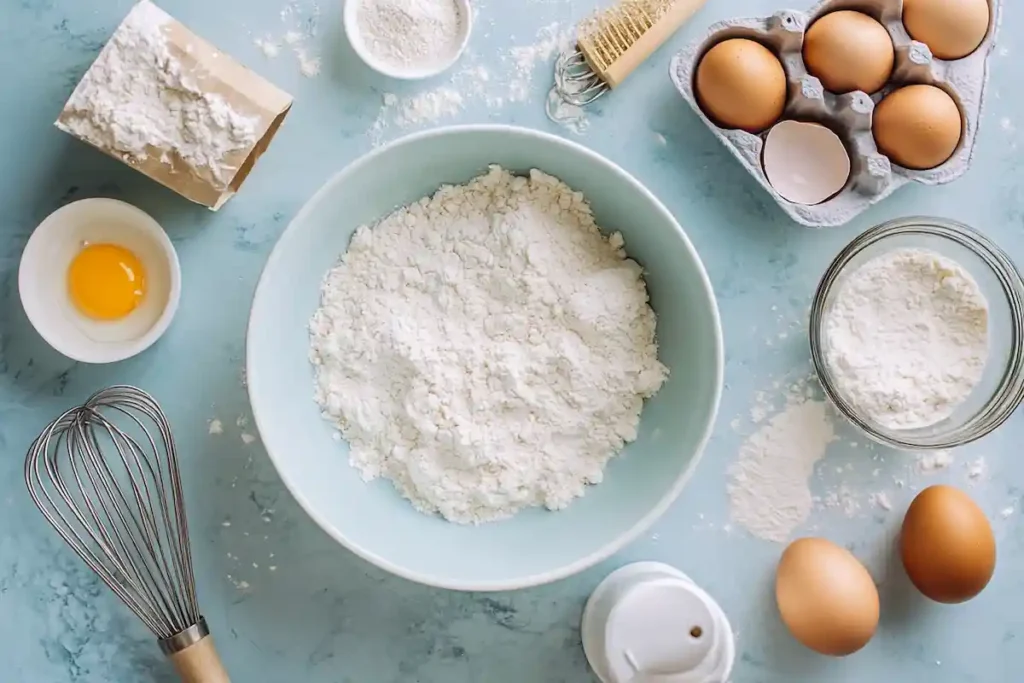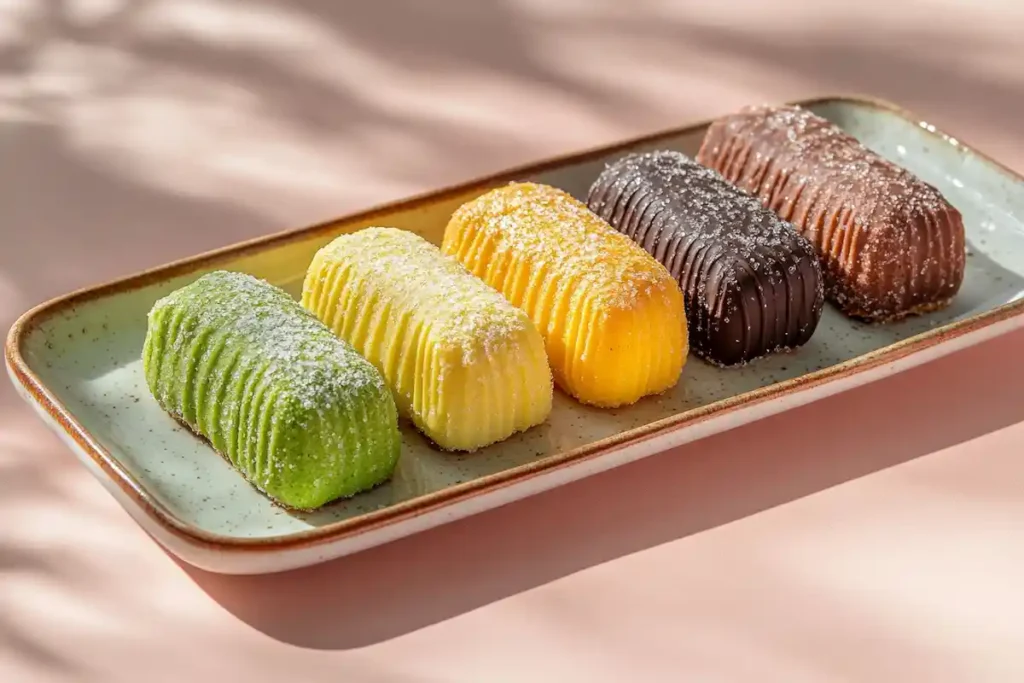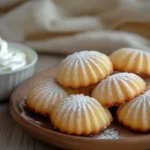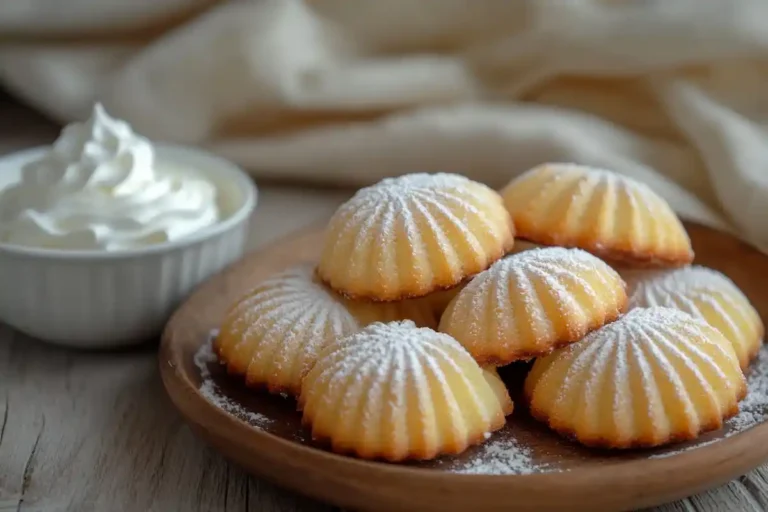Introduction
Are you ready to transform your baking routine with a foolproof madeline cookies recipe using cream? These petite, shell-shaped delights hail from France and have long captured the hearts of dessert lovers around the world. In this comprehensive guide, we’ll walk through each step to help you achieve the softest crumb, the perfect rise, and the signature hump on top that sets these cookies apart from ordinary treats. Whether you’re a beginner seeking a fun weekend baking project or an experienced baker looking to refine your technique, this article has you covered.
We’ve explored the top-ranking posts on madeline cookies recipe using cream and discovered that most recipes share the same basic structure: an ingredient list, step-by-step instructions, helpful tips for achieving the right texture, tasty variations, and frequently asked questions. Here, you’ll also find unique insights that will help your cookies stand out from the crowd. From selecting the best dairy products to mastering batter-chilling techniques, we’ll leave no stone unturned. Prepare your mixing bowl, preheat your oven, and let’s dive into this delectable journey.
1. What Are Madeline Cookies?
Madeline cookies, often spelled as “Madeleine,” are petite sponge-like cookies with a distinctive shell shape. These cookies trace their origins to France, particularly the Lorraine region. With a tender crumb and a slight hump on top, they’re as charming to look at as they are to eat. Their flavor profile is typically buttery, delicate, and lightly sweet, making them perfect for pairing with tea, coffee, or hot chocolate.
Unlike standard sugar cookies or drop cookies, madeline cookies require a specially shaped baking mold. This mold is responsible for creating the cookies’ scalloped surface. When we talk about a madeline cookies recipe using cream, we’re referring to a slight variation in traditional recipes that emphasizes a soft, moist texture. The cream adds a rich dimension to the batter, ensuring each bite is luxurious and memorable.
2. Why Use Cream in Madeline Cookies?
The secret to a melt-in-your-mouth texture lies in the chemistry of adding cream to the batter. Many classic French madeleines rely on whipped eggs and butter to create that characteristic lightness. However, using cream further enhances this quality, lending moisture and a velvety crumb. Cream also helps balance sweetness, preventing the cookies from tasting too sugary. The end result is a refined flavor, ensuring your guests will be asking for seconds.
By opting for a madeline cookies recipe using cream, you can bring a layer of richness that sets your cookies apart from traditional versions. This approach is an excellent way to upgrade a time-honored treat into a modern, indulgent dessert.
3. Essential Tools and Equipment
Baking madeline cookies is simpler when you have the right kitchen tools. Here’s what you’ll need for this madeline cookies recipe using cream:
- Madeline Cookie Mold: Look for a nonstick metal mold with deep shell impressions.
- Mixing Bowls: At least two bowls—one for dry ingredients and one for wet ingredients.
- Whisk or Electric Mixer: A hand mixer or stand mixer speeds up the process of whipping eggs and sugar.
- Rubber Spatula: Perfect for gently folding ingredients.
- Measuring Cups and Spoons: Accuracy is crucial in baking.
- Cooling Rack: Ensures even cooling and prevents sogginess.
If you have a pastry brush, keep it handy. You’ll need it to coat the madeline mold with melted butter or cooking spray, helping your cookies pop out easily once baked.
4. Ingredients You’ll Need
Choosing the right ingredients is key to nailing this madeline cookies recipe using cream. High-quality staples will elevate both the flavor and texture of your final product. While the list below covers the basics, remember that attention to detail—like selecting top-notch butter—can make a big difference.
- All-Purpose Flour
- Granulated Sugar
- Eggs
- Heavy Cream or Whipping Cream
- Unsalted Butter
- Baking Powder (optional, but it can help with the rise)
- Salt
- Vanilla Extract or other flavorings (like lemon zest)
Choosing the Right Cream
For the creamiest texture, opt for heavy cream or whipping cream. These varieties have a higher fat content compared to half-and-half. The additional fat is what contributes a luscious mouthfeel to the cookies. If you can find organic or locally sourced cream, even better—the fresher the product, the richer your madelines will taste.
Quality Butter and Flour
- Butter: Always use unsalted butter so you can control the salt level. Look for European-style butter if possible, as it usually contains a higher fat percentage.
- Flour: Regular all-purpose flour works best. Sift it before measuring to prevent lumps and ensure a lighter batter.
Eggs and Flavorings
- Eggs: Large eggs at room temperature are standard. Room temperature eggs emulsify better with sugar and cream.
- Flavorings: The classic choice is vanilla extract, but you can experiment with almond extract, citrus zests, or even lavender. A small amount of grated lemon or orange zest adds a refreshing twist that complements the creaminess.
5. Step-by-Step Instructions
Below, we’ll dive into our 5-Step Guide that focuses on a madeline cookies recipe using cream. By following these steps carefully, you’ll produce consistently tender, perfectly shaped, and moist cookies every time.

Step 1: Prepare Your Tools and Ingredients
- Gather Ingredients: Measure out your flour, sugar, eggs, butter, cream, and other needed items.
- Preheat Oven: Preheat your oven to 350°F (175°C).
- Grease Madeline Mold: Use melted butter or nonstick spray to coat the mold thoroughly. This prevents sticking and ensures even browning.
Expert Tip: Greasing each shell cavity meticulously is vital. Skimping on this step may result in broken or unevenly baked cookies.
Step 2: Mix the Batter
- Combine Dry Ingredients: In a medium bowl, sift together your flour, salt, and baking powder (if using). Set aside.
- Whip Eggs and Sugar: In a separate bowl, whisk (or use an electric mixer) to beat the eggs and sugar until pale yellow and fluffy. This usually takes 3-5 minutes with an electric mixer on medium-high speed.
- Add Wet Ingredients: Gently fold in the heavy cream, melted butter, and vanilla extract.
- Incorporate Dry Ingredients: Carefully fold the dry mix into the wet ingredients. Use a spatula to maintain the airy texture. Over-mixing can lead to dense cookies, so aim for just until combined.
Expert Tip: Adding the melted butter in a steady stream while whisking can help maintain the batter’s emulsification.
Step 3: Chill the Batter
Many seasoned bakers stress that chilling the batter is a game-changer in any madeline cookies recipe using cream.
- Transfer Batter: Pour the batter into a clean bowl or cover your mixing bowl with plastic wrap.
- Refrigerate: Chill for at least 30 minutes (and up to 1 hour).
- Reasoning: Chilling helps the gluten relax and allows the flavors to meld. It also aids in creating that signature hump on top of each madeline.
Expert Tip: If you have time, try an overnight chill. You may find an even fluffier texture and more pronounced flavor development the next day.
Step 4: Bake to Perfection
- Fill the Mold: Remove the chilled batter from the fridge. Fill each shell in the madeline mold about three-quarters full.
- Bake: Place the tray in the 350°F (175°C) oven for 10-12 minutes, or until the edges turn a light golden brown and the centers spring back when gently pressed.
- Watch Carefully: It’s easy to over-bake madeline cookies, leading to dryness. Stay close to the oven to avoid missing that perfect moment.
Expert Tip: For an even bake, you can rotate the tray halfway through the baking time.
Step 5: Cool and Garnish
- Remove from Mold: Once the cookies are done, immediately invert the mold onto a cooling rack. The cookies should release effortlessly if the pan was well-greased.
- Cool: Allow them to cool for a few minutes on the rack.
- Optional Garnish: Dust with powdered sugar, drizzle with a thin glaze, or dip one side in melted chocolate.
Expert Tip: Let the cookies cool fully before adding any glaze or chocolate, as warmth might cause your garnish to become runny or uneven.
6. Nutritional Information (Per 100g)
Below is the estimated nutritional breakdown for these madeline cookies recipe using cream. Please note that values may vary based on the brands of ingredients and exact measurements used.
| Nutrient | Approx. Value per 100g |
|---|---|
| Calories | 375 kcal |
| Carbohydrates | 45 g |
| Protein | 6 g |
| Total Fat | 20 g |
| Saturated Fat | 12 g |
| Cholesterol | 100 mg |
| Sodium | 180 mg |
| Fiber | 1 g |
| Sugars | 25 g |
These figures are approximations meant to serve as a guide. If you require specific dietary calculations, consult with a nutrition professional or use a reliable nutrition calculator with your exact ingredient quantities.
7. Pro Tips and Tricks
- Room Temperature Eggs: Cold eggs won’t whip up as effectively, so bring them to room temperature for a fluffier batter.
- Gentle Folding: Over-mixing can knock out the air you worked so hard to incorporate. Always fold ingredients gently.
- Time Your Baking: Madeline cookies can go from golden perfection to overcooked in under a minute. Keep an eye on them after the 8-minute mark.
- Flavor Infusions: Explore beyond vanilla—try mixing in spices like cinnamon or nutmeg, or even a few drops of almond extract.
The biggest takeaway here is technique plus patience. The best madeline cookies recipe using cream relies on consistent handling of batter, proper chilling, and precise baking times.
8. Delicious Variations
Experimenting with flavors and presentations can take your madeline cookies recipe using cream to the next level. Here are some creative twists:
- Lemon Zest Madelines
- What to Do: Add 1 tablespoon of fresh lemon zest to the batter.
- Flavor Impact: A bright, zesty note that pairs beautifully with the cream’s richness.
- Chocolate-Dipped Madeleines
- What to Do: Dip cooled cookies in semi-sweet or dark chocolate.
- Flavor Impact: The slight bitterness of chocolate complements the cookie’s buttery sweetness.
- Lavender Infusion
- What to Do: Steep 1 teaspoon of food-grade lavender buds in warm cream for 10 minutes. Strain before adding to the batter.
- Flavor Impact: A subtle floral aroma that adds an elegant twist.
- Matcha Madeleines
- What to Do: Add 1 tablespoon of matcha powder to your flour mix.
- Flavor Impact: An earthy, slightly sweet profile that balances nicely with cream.

These variations cater to diverse palates, ensuring that each bake offers something new and exciting. Don’t be afraid to experiment with flavor extracts, glazes, and toppings to discover your perfect combination.
9. FAQs
Below are four of the most searched questions in “People Also Ask” for madeline cookies recipe using cream. We’ve answered them comprehensively to fill gaps often left by competitors.
What does cream do in cookies?
Cream plays a major role in enhancing both the texture and taste of cookies. In madeline cookies recipe using cream, it provides added moisture and a plush, velvety crumb. The fat content in cream also enriches the overall flavor, making each bite more indulgent. Beyond texture, cream can help balance sweetness and create a subtle tang that sets these cookies apart from standard recipes using only butter.
How to keep madeleines moist?
Keeping madeleines moist involves several key steps:
- Do Not Over-Bake: Even a minute too long in the oven can cause dryness.
- Use High-Fat Cream: The added richness from heavy cream or whipping cream retains moisture.
- Store Properly: Place them in an airtight container as soon as they cool.
- Add Glaze: A thin layer of glaze or a dusting of powdered sugar helps lock in moisture.
By diligently following these guidelines, you’ll maintain soft, tender cookies for days after baking.
Why do madeleines taste so good?
Madeleines deliver a delicate balance of flavors—rich butter, sweet sugar, and the subtle hint of vanilla or citrus. Their airy texture feels almost like a mini cake, while their caramelized edges offer a satisfying contrast in taste and texture. When you choose a madeline cookies recipe using cream, the cream adds extra depth, making the cookie even more flavorful. The process of whipping eggs and sugar creates a light batter, while the signature hump shape ensures there’s a variety of textures within each bite.
Why do you chill madeleine batter?
Chilling the batter helps the gluten strands relax, which prevents the cookies from becoming tough or dense. It also allows the flavors to meld and intensify. More importantly, cool batter hitting a hot oven promotes a rapid rise, giving you that iconic hump on top of each cookie. This step is particularly important in any madeline cookies recipe using cream because the cream needs time to integrate fully with the rest of the ingredients, resulting in a moist and flavorful cookie.
Conclusion
In summary, a madeline cookies recipe using cream combines classic French technique with a rich twist—heavy cream. This simple addition amps up the cookie’s flavor profile and texture, ensuring a moist crumb and luxurious taste. Whether you stick to a traditional vanilla approach or explore creative variations like citrus zest, matcha powder, or chocolate dips, the keys to success remain the same:
✔ Use High-Quality Ingredients – The best results come from premium butter, fresh cream, and pure vanilla extract. Avoid low-fat alternatives, as they may compromise the rich texture of your cookies.
✔ Fold the Batter Gently – Overmixing can lead to dense cookies. Carefully incorporate the dry ingredients into the wet mixture to maintain the batter’s lightness.
✔ Chill Thoroughly – Refrigerating the batter is a crucial step. It enhances flavor development, improves texture, and ensures the signature madeleine hump.
✔ Monitor Baking Time – Even a minute too long in the oven can dry out your cookies. Keep an eye on them after 8 minutes to achieve the perfect golden-brown color.
✔ Serve and Store Properly – Madeleines are best enjoyed fresh, but if needed, store them in an airtight container to preserve moisture. A light dusting of powdered sugar or a delicate glaze can elevate their presentation.
By mastering these principles, you’re on your way to producing a batch of madeline cookies that rivals the finest pâtisseries in France. Enjoy them as a morning treat with coffee, an afternoon snack with tea, or a post-dinner dessert that delights friends and family alike. Their elegant shape and delicate texture make them a timeless addition to any dessert table, perfect for special occasions, gatherings, or a simple indulgence at home.
Baking is as much about the experience as it is about the result. So, whether you are making these cookies for the first time or refining your technique, embrace the process, have fun, and let the sweet aroma of fresh-made madeleines fill your kitchen with warmth and joy. Happy baking!
Print
Madeline Cookies Recipe Using Cream
- Total Time: 27 minutes
- Yield: 12 cookies 1x
Description
Delight in the classic French charm of Madeline cookies, enhanced with the richness of cream. These petite, shell-shaped sponge cakes boast a tender crumb and a delicate sweetness, making them perfect companions to your favorite hot beverage.
Ingredients
- 1 cup all-purpose flour
- 1/2 cup granulated sugar
- 2 large eggs
- 1/4 cup heavy cream
- 1/2 cup unsalted butter, melted and cooled
- 1 teaspoon baking powder
- 1 teaspoon vanilla extract
- Pinch of salt
Instructions
- Prepare the Mold: Grease the Madeline cookie mold with melted butter or cooking spray, ensuring all crevices are coated.
- Mix Dry Ingredients: In a bowl, whisk together the flour, baking powder, and salt.
- Whip Eggs and Sugar: In a separate bowl, beat the eggs and granulated sugar until the mixture is pale and fluffy.
- Incorporate Wet Ingredients: Add the heavy cream and vanilla extract to the egg mixture, stirring until combined.
- Combine Mixtures: Gently fold the dry ingredients into the wet mixture until just combined.
- Add Butter: Fold in the melted butter, ensuring the batter is smooth and well-mixed.
- Chill the Batter: Cover the bowl and refrigerate the batter for at least 30 minutes to help achieve the classic Madeline hump.
- Preheat Oven: While the batter chills, preheat the oven to 375°F (190°C).
- Fill the Mold: Spoon the batter into the prepared Madeline mold, filling each cavity about three-quarters full.
- Bake: Bake for 10-12 minutes, or until the edges are golden and the centers spring back when lightly touched.
- Cool and Serve: Remove the cookies from the oven, allow them to cool in the mold for a few minutes, then transfer to a cooling rack. Serve warm or at room temperature.
Notes
- Storage: Store cooled Madeline cookies in an airtight container at room temperature for up to three days.
- Variations: For a citrus twist, add a teaspoon of lemon or orange zest to the batter.
- Serving Suggestion: Dust with powdered sugar before serving for an elegant presentation.
- Prep Time: 15 minutes
- Cook Time: 12 minutes
- Category: Dessert
- Method: Baking
- Cuisine: French
Nutrition
- Serving Size: 1 cookie
- Calories: 150
- Sugar: 10g
- Sodium: 50mg
- Fat: 8g
- Saturated Fat: 5g
- Carbohydrates: 17g
- Fiber: 0g
- Protein: 2g
- Cholesterol: 45mg
Keywords: Madeline cookies, French dessert, cream-infused cookies, shell-shaped sponge cakes

